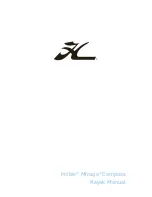
127
Seasonal Maintenance
A recommended alternative to the above-men-
tioned procedure is the use of commercially avail-
able non toxic, fresh water system antifreeze.
After draining the fresh water tank, lines and
filters, pour the antifreeze mixture into the fresh
water tank, prime and operate the pump until the
mixture flows from all fresh water faucets and the
hardtop shower. Be sure to open all water faucets,
including the fresh water washdown hose and flush
the toilet several times. Make sure antifreeze has
flowed through all of the fresh water drains.
For additional information refer to the Fresh Water
System and Drainage Systems chapters.
14.3 Raw Water System Winterizing
The raw water washdown and seawater supply
pumps and systems must be completely drained
and winterized using the following procedures.
Sea Chest & baitwell Water Supply System
The sea chest and baitwell water supply system
require the following procedure to be properly
winterized with boat out of the water.
1. Open the thru-intake valves to drain all water
from the intake lines and sea chest.
2. Remove and clean the strainer screen in the
scoop for the primary supply hose. Reassemble
the strainer.
3.
Close the intake valves and fill the sea chest
with potable water antifreeze.
4. Run the baitwell pumps one at a time until
the antifreeze solution is visible at the baitwell
supply valves. Open the drain valves and
continue to run the pump until antifreeze has
flowed through the baitwell drain thru-hull
fittings. Refill the sea chest as required to
accomplish this.
Raw Water Washdown System
Open the thru-hull valve, disconnect all hoses
and blow the water from the system. Use only
very low air pressure when doing this to prevent
possible system damage. Because of the check
valve mechanism built in the raw water washdown
pump, blowing the lines will not remove the water
from the raw water pump. Remove the inlet and
outlet hoses on the pump. Turn the pump on
and allow it to pump out any remaining water....
about a cupful.
A recommended alternative to the above-men-
tioned procedure is the use of potable water
system antifreeze. If potable water antifreeze
is used, pour the mixture into a pail and put the
raw water pump intake line into the solution. Run
the pump until the antifreeze solution is visible at
all raw water faucets and discharge fittings. Be
sure antifreeze has flowed through all of the raw
water drains.
Fishbox Pump Out System
Run the fish box pumps until all the water is re
-
moved from the fish boxes and the pump. Then
pour potable water antifreeze in each fish box and
activate the pumps until antifreeze is visible at the
discharge thru-hull fittings. To avoid damage to
the pumps, be careful not to run the pumps dry
for more than a few seconds.
Marine Toilet
The marine toilet must be properly winterized by
following the manufacturer’s winterizing instruc-
tions in the marine toilet owner’s manual. Drain
the intake and discharge hoses completely using
low air pressure if necessary. The head hold-
ing tank and overboard discharge pump must
be pumped dry and one gallon of potable water
antifreeze poured into the tank through the deck
waste pump out fitting. After the antifreeze has
been added to the holding tank, open the over-
board discharge valve and activate the overboard
macerator pump until the antifreeze solution is
visible at the discharge thru-hull.
Notice:
Make sure you follow the marine toilet manu-
facturer’s winterizing instructions exactly.
The freshwater supply line to the toilet must
be properly winterized when winterizing the
fresh water system.
Bilge
Coat all metal components, wire busses and con-
nector plugs in the bilge with a protecting oil. It
is also important to protect all strainers, seacocks
and steering components. The bilge pumps and
bilge pump lines must be completely free of water
and dried out when the boat is laid-up for the win-
ter in climates where freezing occurs. Compart-
ments in the bilge that will not drain completely
should be pumped out and then sponged until
completely free of water. Dry the hull bilge and
self-bailing cockpit troughs. Water freezing in
these areas could cause damage.
Summary of Contents for 33 CSF
Page 1: ...Crevalle 33 CSF Owner s Manual...
Page 2: ...2...
Page 10: ...10 NOTES...
Page 14: ...14 NOTES...
Page 23: ...23 Operation...
Page 74: ...74 NOTES...
Page 78: ...78 NOTES...
Page 84: ...84 NOTES...
Page 116: ...116 NOTES...
Page 124: ...124 NOTES...
Page 130: ...130 NOTES...
Page 146: ...146 NOTES...
Page 167: ...167 MAINTENANCE LOG Appendix C Date Hours Dealer Service Repairs...
Page 168: ...168 Maintenance Log Date Hours Dealer Service Repairs...
Page 169: ...169 Appendix D BOATING ACCIDENT REPORT...
Page 170: ...170 Boating Accident Report...
Page 171: ...171 Boating Accident Report...
Page 172: ...172 NOTES...
Page 174: ...174 NOTES...
Page 180: ...180 NOTES...
Page 186: ...186...
Page 187: ...187 CAUSE AND SOLUTI...
















































